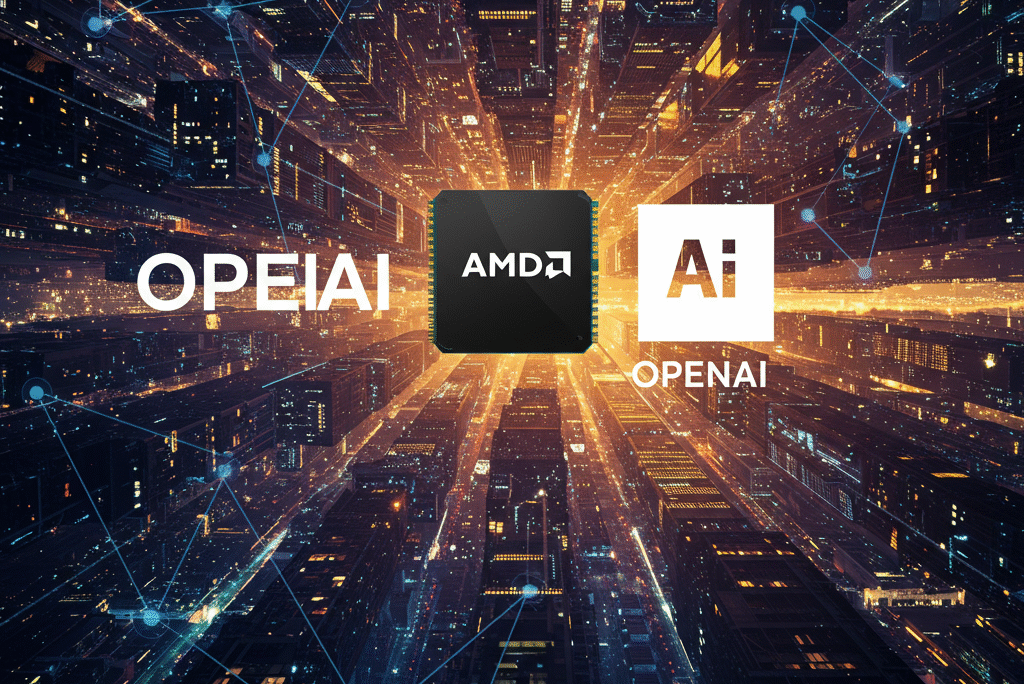In the high-stakes world of artificial intelligence, one company has stood as the undisputed king of the hardware that powers it all: Nvidia. For years, their GPUs and the powerful CUDA software ecosystem have been the default choice for training and running the world’s most advanced AI models. But the landscape is shifting. In a move that sent ripples through the tech industry, AMD has officially teamed up with OpenAI, the trailblazing research lab behind ChatGPT and DALL-E. This isn’t just another partnership; it’s a strategic alliance poised to challenge Nvidia’s long-held supremacy and reshape the future of AI computation.
So, what does this collaboration actually mean? Is the throne finally being contested? Let’s dive deep into the details of this new alliance and explore its massive implications for developers, businesses, and the entire AI industry.
The Unquestioned King: Understanding Nvidia’s AI Moat
To grasp the significance of the AMD-OpenAI news, you first have to understand why Nvidia is so dominant. It’s not just about having the fastest chips. Their true advantage—their “moat”—is CUDA, a proprietary software platform and programming model that allows developers to unlock the massive parallel processing power of Nvidia GPUs for general-purpose computing. For over a decade, the AI and machine learning community has built its tools, libraries (like TensorFlow and PyTorch), and workflows almost exclusively on top of CUDA. This created an incredibly sticky ecosystem. Switching from Nvidia wasn’t just a matter of buying different hardware; it meant rewriting code and re-training entire teams, a costly and time-consuming endeavor. This software lock-in has allowed Nvidia to command over 80% of the AI chip market, leading to soaring demand and legendary shortages of their flagship H100 GPUs.
A New Alliance is Forged: AMD and OpenAI Enter the Arena
Enter AMD. While a giant in CPUs and gaming GPUs, they have historically been a distant second in the data center AI space. But they’ve been working tirelessly on a challenger: the Instinct MI-series accelerators and their own open-source software platform, ROCm (Radeon Open Compute platform). The blockbuster announcement is that OpenAI is now actively collaborating with AMD to validate and use their latest flagship chip, the Instinct MI300X, in their AI infrastructure. OpenAI President Greg Brockman confirmed they are adding the MI300X to their systems, a massive vote of confidence from the most influential AI company in the world. This is the seal of approval AMD needed to prove that their hardware and, crucially, their software are ready for prime time.
Why This Partnership is a Game-Changer for the AI Industry
This collaboration is more than just a win for AMD; it’s a pivotal moment for the entire AI ecosystem. Here’s why it matters so much:
1. Real Competition Finally Arrives: For the first time, Nvidia faces a credible, high-profile competitor backed by a top-tier AI leader. This competition is essential. It will inevitably lead to more aggressive pricing, faster innovation, and more choice for companies building AI products. The era of a single-supplier market may be coming to an end.
2. Diversifying a Fragile Supply Chain: The AI boom has been hampered by a critical shortage of high-end GPUs. A single company, Nvidia, has been the bottleneck for the entire industry’s growth. By validating and adopting AMD’s hardware, OpenAI and other major players can diversify their supply chains, reducing their reliance on a single vendor and creating a more resilient hardware foundation for future AI development.
3. A Massive Boost for the ROCm Software Ecosystem: Hardware is only half the battle. The real challenge for AMD has been convincing developers to move away from the familiar comfort of CUDA. With OpenAI actively using and contributing to the ROCm ecosystem, it sends a powerful signal to the rest of the community: ROCm is a viable, powerful alternative. This will likely trigger a snowball effect, encouraging more developers and companies to support and build for AMD’s platform, weakening CUDA’s iron grip.
The MI300X vs. The H100: A Titan-Sized Showdown
At the heart of this battle is AMD’s MI300X accelerator, designed to go head-to-head with Nvidia’s H100. While benchmark wars can be complex, AMD is highlighting a key advantage: memory. The MI300X boasts an impressive 192GB of HBM3 memory, significantly more than the H100’s 80GB or 120GB configurations. Why is this a big deal? Large Language Models (LLMs) like GPT-4 are incredibly memory-hungry. More memory on a single chip means you can fit larger, more complex models without having to split them across multiple GPUs, which simplifies development and can improve performance. While Nvidia still has a significant lead in software maturity and market penetration, AMD is clearly attacking a critical pain point for AI developers working at the cutting edge.
What This Means for Your Business and the Future
For business leaders, developers, and tech strategists, this shift in the AI hardware landscape is critical to watch. The key takeaway is that the ground is moving. The assumption that high-performance AI is synonymous with Nvidia is no longer a given. In the near future, we can expect:
- More Accessible AI Compute: As competition heats up, the cost of the hardware needed to train and deploy AI models is likely to decrease, making powerful AI more accessible to a wider range of businesses and startups.
- Increased Innovation: With two tech giants competing fiercely, the pace of hardware and software innovation will accelerate, bringing even more powerful capabilities to market faster.
- Greater Flexibility: A more mature open-source software alternative in ROCm gives developers more flexibility and reduces the risk of being locked into a single proprietary ecosystem.
The AMD-OpenAI partnership is not just a ripple; it’s a seismic event. It signals the beginning of a new, more competitive era in the AI hardware industry. While Nvidia’s reign is far from over, the walls of its kingdom now have a formidable challenger at the gates. The ultimate winner in this battle of titans won’t just be AMD or Nvidia—it will be the entire world of artificial intelligence.
Is your business prepared to leverage the next wave of AI innovation? The evolving hardware landscape is creating unprecedented opportunities. Now is the time to re-evaluate your AI strategy and ensure you have the right partners to guide you. Contact our team of experts today to explore how the latest advancements in AI hardware and software can power your company’s growth and secure your competitive edge.





